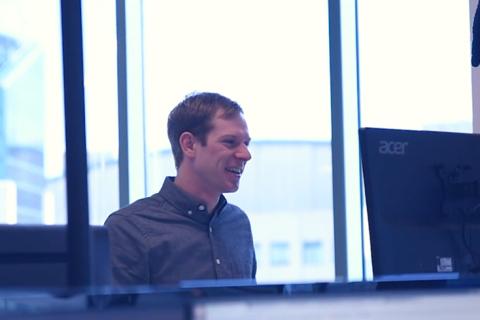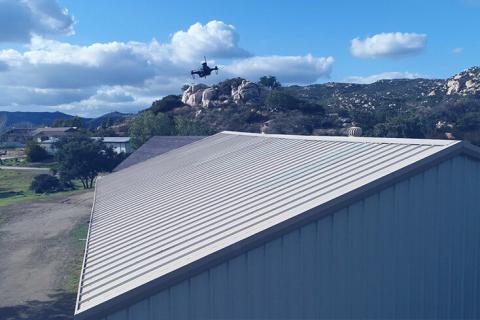[September 12, 2019]
Shield Spotlight Tristan Novak

How did you first become interested in engineering?
I’ve always enjoyed building things, creating plans and designing something new. I grew up doing a lot of mechanical work and other hands-on activities, such as woodworking, metalworking, and automotive work.
As early as elementary school I remember designing things and building them out of wood. I had a box where I kept all of my plans and templates and paper drawings of what I created. That was my database. It housed all the designs that I had completed and all of the notes I took when manufacturing them. But, of course, I was just a little kid and didn’t really know I was drafting prototypes or managing a database. I was just playing around and exercising my creativity.
I began welding in middle school, and soon I was making all kinds of creations, using old bicycle parts to make weird-shaped vehicles. I don’t think that it came as a surprise to anybody when I decided I wanted to become an engineer.
Why did you choose to focus on electrical engineering, rather than another discipline?
Initially, when I went to college, I planned to focus on mechanical engineering because that’s what I was familiar with. But, at Clemson, students don’t declare their specific engineering majors — mechanical, biological, chemical, etc. — until sophomore year. So, in my first year I got exposed to electrical engineering. I think it is a good case example of why you shouldn’t always stick to what you’re familiar with.
Learning electronics was really new and exciting for me, and I immediately saw the utility of it all. It was really rewarding to code a program to recognize objects in an image or to design hardware to make a light blink. Having that feedback loop, that tangible thing to see or hold as a result of your work, really resonated with me because I’m such a hands-on person. I derive a strong sense of accomplishment when I get a new design working.
What else about electrical engineering drew you in?
One thing that really attracted me to electrical engineering from the outset is that every new design is fresh. Once you design a circuit board, you won’t ever design that circuit board again. It already exists.
And so everything you do has a “new” element to it. Each project will have new requirements, features, and so forth. You’ll always start from the same basic principles but, even if you’re using all the same sub-circuits, the pieces will fit together differently. You carry on a lot of knowledge in terms of what has worked in the past but, in general, every time you start a new design it’s like you’re building a new product.
That’s especially true about my work at Shield AI. Every single project I do is new and different and has new requirements. That’s what makes it exciting.
Before you joined Shield AI you were involved in several interesting research projects — designing circuits to wirelessly control the locomotion of insects and a noninvasive human brain stimulator for neuroscience research. Can you tell us about what interested you in these subjects?
One unifying element that I found particularly compelling about all of my projects in grad school was how electricity naturally presents itself and is used in nature. It’s pretty interesting to consider electricity in nature; people typically think of electricity as this technology that humans invented to power their lights, but it’s not at all. It’s something that’s already present in nature.
For instance, a cockroach’s antennae are essentially transducers that convert mechanical movement into electrical signals. During grad school, I worked on a short-term interdisciplinary project with the entomology department assisting with research in characterizing the chemical response of insect antennae. We were researching how to control the movement of the cockroach by spoofing the mechanical input of the insect’s antenna with an electrical signal.
At the start of that project, I had a basic working knowledge of how electricity is used, observed, and quantified in nature, but I had no expertise in the biology of insects. So naturally, I needed to establish close collaboration with the entomology department to understand not only the problem at hand — what they were studying in the insects that they were raising — but also the science behind how to evaluate the outcome of the tests we wanted to perform. I spent a lot of time in their lab observing the experiments, learning how to use the equipment, and prototyping different circuits. Working together, we created a circuit that would read the electrical signals generated when different chemicals were passed by the antenna and amplify them such that they would be observable to the person doing the experiments.
Overall, I found these research projects interesting because there were typically focused on something I knew nothing about. For all the projects that I assisted with, I was brought on to build devices and circuits to support other people’s research projects. And, because of that, I had to do a lot of research on many different topics to figure out how exactly to convert a high-level theoretical solution into one that could be defined and built with electric circuits, down to the resistor level. That same theme of being attracted to learning and tackling new projects transferred into my first job, consulting engineering. Every single project was different and, oftentimes, I didn’t begin the project as an expert in the subject matter. I think that quality and hunger for knowledge is pretty handy to have at a growing company like Shield AI.
Another commonality between all of my research and consulting projects — and most of what I do at Shield AI — is that they all start with a broad problem statement. At Shield AI, we’re often faced with a really broad problem and somehow we have to get from there to determining what circuit-level solution makes sense. To effectively find a solution, I need to gain background knowledge on the subject, research different ways to solve the problem and learn what would be the most useful to the customer.
When you are faced with projects that require you to learn a lot of new material, what do you do?
I don’t think of myself as an especially smart or talented person — just like anyone, I get confused and overwhelmed by lots of information. So, in those situations, I spend a lot of time organizing and simplifying things. My success is largely dependent upon making my learning process efficient and learning how to use my mind to take in information, process it, recall it, et cetera. It’s all about condensing information and organizing information both physically and conceptually.
While I’ve learned how to successfully master new information in an academic environment, that doesn’t mean anything when it comes to real-world problem solving. Academic concepts are typically presented in a very well-defined and predictable environment. In the real world, there will always be challenges, intricacies, and complications (both technical and non-technical), so it’s important to also figure out how to be passionate about new engineering challenges.
Is there one project you’ve worked on during your time at Shield AI that you recall the most fondly?
One of the first projects I worked on at Shield AI — and also one that I am most proud of — was designing the GPS for Nova. When Nova was initially designed, the prevailing thought was that we would be able to rely upon an off-the-shelf solution for some of its hardware components. However, as we progressed with designing the product, it became evident that we would need to build more custom hardware solutions in-house. Off-the-shelf solutions were not always robust enough or reliable enough, and they did not always have a consistent enough supply chain to meet the needs of our customers. Because I had experience incorporating GPS to several products in previous jobs, I was able to quickly and effectively design a new system for Nova which addressed those reliability and supply chain concerns.









